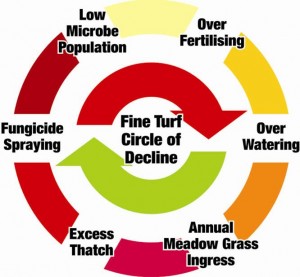The diagram below shows the process that many poorly maintained bowling greens experience over a period of years if 3 basic maintenance issues are not addressed as a priority.
The top 3 issues on all fine turf are:
1. Thatch Control
2. Compaction Control
3. Turf Nutrition

In addition to the top 3 there are of course other important issues such as irrigation management, topdressing etc, but if these 3 big issues are under-managed then the green will spiral into what I have called the Circle of Decline.
Simply put this is the course of events that go on largely un-noticed by many bowling clubs until it is too late to effect a quick recovery.
A lack of attention to thatch build up (see other posts under the thatch category) results in a thick mat of un-decomposed dead grass shoots, roots and leaves. This mat gradually effects the turf’s ability to put down roots and take up water and nutrients. In advanced cases a root break will occur and Localised Dry Patch is a very common symptom of excessive thatch also (see other posts under the LDP category)
Disease
In winter, thatch can hold water like a sponge and encourage fungal diseases such as fusarium patch to take hold. This sometimes results in over use of chemical fungicides which kill off the disease and many beneficial fungi into the bargain.
Symbiosis
Grass relies on beneficial microbes, such as fungi to make best use of the available nutrition and so begins to have difficulty obtaining the necessary nutrition from the soil.
This often results in over fertilisation, as much of what is applied is not made available to the plants due to the anaerobic conditions which now prevail.
By now conditions are highly favourable to the weed annual meadow grass which is a very shallow rooting species. The finer fescue and bent grasses are compromised and in an effort to keep the meadow grass alive excessive irrigation is required.
This contributes even further to the excessive thatch layer as meadow grass is a prolific producer of thatch and we are back to the beginning of the cycle.
Action must be taken to break into the circle of decline, take action before its too late for your green.

There seem to be two soil analysis available from you. Which one do I need to check if we have too much thatch and don’t need a sand top dressing this autumn please?
Natalie Chalcraft Sawbridgeworth Bowling Club
Hi Natalie
Thatch can be checked without a soil analysis. Please see here.
The soil analysis you need for chemistry and soil textural analysis is here.
Regards
John